I met Jonathan Porter, the founder of Chicago Pizza Tours, last winter, and he was kind enough to not only share a ton of pizza-related advice and stories with me, but also to invite me out for a tour with my friend (and strong Chicago pizza opinion haver), Tim Giuffi of Lyman Ave. Bread.
In part one, I went over the structure of the tour itself and talked about the history (and the pizza), of our first two stops; Pizano’s and Flo and Santo’s. For part two we’ll dig further into our final stops; Coalfire and Bartoli’s. Jonathan once again gave me a ton of additional background into how he built up his relationships with the pizzerias, and let me know why he thinks they’re noteworthy stops for people experiencing Chicago pizza for the very first time.
If you happened to miss the first part, you can get caught up right here.
Third stop!
Coalfire is Chicago’s only pizzeria that currently bakes with a coal oven, and they pride themselves on their “ thin crust, coal-forged pizza that emerges slightly charred and bubbly from our 1,500 degree oven fueled by clean burning coal.” One of the main advantages of a coal oven, as opposed to gas or wood, is the incredibly high temperatures it can reach. The extreme heat gives the pizza a different kind of char, while also creating a crispy shell on the outside of the crust that keeps the inside of the dough tender. All the original New York pizzerias used coal ovens, and some of my favorite pizza restaurants in New York (like John’s and Patsy’s to name a few) continue to, even if it’s become a major topic of controversy the last few years.
The tour visited Coalfire’s location on Grand in West Town — they have a second pizzeria on Southport in Lakeview as well as a classic Italian restaurant called Peanut Park Trattoria (which is wonderful) on Taylor Street in Little Italy — and of the four stops we made I enjoyed the experience at Coalfire the most, primarily because Jonathan took us into the kitchen to give us a close up look at their oven.


My favorite piece of info on the entire tour was that Coalfire’s oven runs so hot that after it’s extinguished on Sunday night (they’re closed Mondays) it still registers 300–400 degrees on Tuesday morning when they come in to relight it.
Just like Pizano’s, Coalfire has been a staple of Jonathan’s tours since the beginning:
“I was living in Bucktown until 2005, then I moved to the South Loop but still kept my place, so I was constantly going back and forth. When you don’t want to take the Kennedy, I would take Ashland to Grand, Grand through the West Loop, then cut down south. I remember one night in 2007 I was driving by, and I got stopped at the light at Ogden, and I look to the right and see a place I’ve never seen before. And I can literally see the fire in there. This is 2007 in Chicago, and for all the places we know now with wood fired ovens, Coalfire in 2007 is the first time I saw a legitimate lit flame through the door. I think they opened in May, and I tried it in late July or August. I just remember it was so good, and at the same time it was so different than anything I’d grown up eating. In summer 2007 the pizza tour isn’t on my mind at all, it doesn’t even enter my mind until late 2008. When I first decided to do the tours, I didn’t want to do a walking tour because all the pizzerias that were within walking distance of each other downtown weren’t a very good representation of what Chicago pizza is. I’m talking Uno’s, Giordano’s, and Gino’s East. That’s not the vision that I had for what I thought the pizza tour should be. Places like Piece, Spacca Napoli, and Coalfire had opened up and were paving the way for other styles of pizza to exist in Chicago. And at the time, and this has since changed, if you wanted to get pizza like that you needed to leave downtown and go to an actual neighborhood. That’s why I wanted to start downtown in a central location then take you out into the neighborhoods to see a different side of pizza in Chicago. So places like Coalfire were the reason why I worked so hard to make it a bus driven tour. If you’re staying at a hotel in River North in 2010 and you ask the concierge where you should go get pizza, there’s a zero percent chance he’s telling you to hop a cab to Grand and Ogden to try Coalfire. It’s hard to put into words how important they’ve been. And the owner, Dave, says the same thing to me about the tours. He truly believes that having that bus parked out front, and people seeing groups and tours go inside, that was a signal to the neighborhood that something good is going on inside there.”
Getting close enough to the oven to risk melting my phone in order to score a video is exactly the type of fearless journalism you can continue to expect from Chicago Pizza News (and as a bonus, you can also hear Tim and Jonathan talking about the price of Gozney pizza ovens in the background)!
The oven often winds up stealing the show, and I asked Jonathan where the idea to step into the kitchen initally came from:
“I have to credit Scott from Scott’s Pizza Tours for that. The kitchen in Coalfire is obviously open, and in the early days I would bring groups of six and stand along the side. When I took one of Scott’s tours in March 2010 shortly before I launched, we started the tour by walking into a pizzeria that wasn’t open yet. We walked into the kitchen, and he showed us this massive coal oven and told us all about how everything works. I thought it would be so cool if I could do that too. So it started at Coalfire with me doing it from the side, but then one of the owners said, “I don’t care if you want to come in. You can’t contaminate the oven.” And I was like, “What do you mean?” And this was one of the original owners who always looked at me like I was an idiot, and he grabbed the thermometer gun and goes, “It’s 900 degrees, man. Nothing lives in there.” People’s eyes light up when they get a chance to go look at it. Then they sit back down, and a few minutes later the pizzas hit the table, and they were just in that kitchen, so it’s romanticized it before they started eating it.”
The pizza at Coalfire is an original recipe that’s completely unique. I may have compared it to some classic New York pizzerias, but that’s more on the technique side because it’s baked in a coal oven, as opposed to the actual taste of the pizza itself. Our tour guide, James, referred to it as New Haven-style, but when I asked Jonathan how he would classify it, he gave me a much different different answer:
“The guys who first started doing their pizza were from Western Massachusetts. So it’s just this East Coast, artisan, bread based dough recipe that’s mixed with midwest toppings. I’ve been in New York, and I’ve had lots of pizzas, and there might be doughs and crusts that are somewhat similar, but nothing like the toppings. The toppings are drastically different. Midwest cheeses. In the earliest inception they were getting their sausage from Bari down the street. New Haven has more of that real crispiness, that real chewy type dough, whereas Coalfire is really going for more of a softer pizza. Crisp on the outside, but the inside should be pretty soft. An East Coast pizza with Chicago flavors. I think one time we called it pizza de nom. The pizza without a name.”
While Coalfire’s style may not be easy to classify, the attention to detail on their pizzas certainly is. Owner Dave Bonomi is a proponent of using local vendors and growers, and Coalfire even goes so far as to include a list of those suppliers on their menu so you know exactly where everything is coming from:
And because they use so many different fresh ingredients, it’s possible to see entirely different pizzas every time you visit, which is part of the reason why Jonathan can’t decide on a favorite:
“Dave was always a farm to table guy, before it was trendy to do that. It’s really is a matter of, let me take a look at the menu and see what’s new. Last time I was there I got a pizza with Ramps and Andouille on it. And Ramps are only in season for a matter of weeks. But day in, day out, people love the pepperoni and whipped Ricotta. They have one with bacon jam on, that’s another good one but it’s a really strong flavor. I don’t know if I can give you a good answer on what my favorite pizza from Coalfire is. I just grab the menu and whatever I’m in the mood for that day. They do everything really well.”
Final stop of the day!
Bartoli’s is a classic Chicago deep dish pizzeria with outposts in Roscoe Village and West Town (which is the location we visited on the tour), that can trace it’s lineage all the way back to the first major evolution in deep dish pizza’s original form.
Owner Brian Tondryk is the grandson of Fred Bartoli, and Bartoli — along with fellow taxi driver Sam Levine and their friend George Loverde — was one of the founders of the original Gino’s East, which opened at 162 E Superior Street in 1966. Bartoli and Levine used to drive their taxis up and down the Magnificent Mile, and they knew a pizza spot right off of this busy stretch of road would be a big hit.
Brian decided to continue his family’s legacy by perfecting his grandfather’s recipe and opening the first Bartoli’s in Roscoe Village in 2013. He opened the second Bartoli’s in West Town in 2020, which proved to be challenging for a multitude of reasons, but primarily because of the timing in regard to the pandemic.
Much like Coalfire, Jonathan came across Bartoli’s by fate, but in actuality he’d been looking for it for a long time without even realizing it:
“As a kid, my favorite deep dish was Gino’s East. A good friend of mine had an older brother, and when he got his license and his 1970 Volkswagen Rabbit — I was 14 or 15 at the time — we’d shoot down to Chicago on a Saturday night, go wait in line at Gino’s for an hour, order the pizza and wait another hour, then eat it, and that was our whole Saturday night. We’d do that once a month. So it’s my measuring stick deep dish. I worked with Gino’s East in the early days of the pizza tour, and they were stop number four. So you’re juxstaposing Pizano’s versus Gino’s, which are drastically different deep dishes. Two pizzerias in the story of the invention of deep dish, because Gino’s is the first competitior of Uno and Due. But Gino’s has changed. The business has been sold a couple of times. And anybody sitting there telling you this is the way we’ve always made the pizza, it’s still the old school way, that’s just not the case. I remember what it tasted like. And more importantly, I remember what it looked like. For a while we’re starting at Pizano’s. Then Coalfire became our second stop. Pequod’s was inserted as our third stop. Then we’re doing Flo & Santo’s to finish up. So I’m hanging out with one of those same guys I used to go to Gino’s East with, it was a random Tuesday, we’re going to Pete’s on Western to get some thin crust, and as we’re driving down Addison I see a sign that says Bartoli’s. So we’re stopped in traffic, again, and I’m staring at the sign and I’m wondering if it has anything to with Fred Bartoli from Gino’s East. So we called the audible, whipped the car around, and walked in. And sure enough it’s deep dish pizza, they have slices in the case, and they tell us it’s gonna be 45 minutes for a fresh one. When the pizza came out and my buddy and I are eating it we’re like, dude, this is that pizza from when we were kids. This is it. And I don’t remember if I talked to Brian that day, or if I came back and introduced myself, but he told me it was his grandfather’s recipe. The problem was it was at Addison and Damen, and it would have been difficult, especially with the drive back. I didn’t think I could pull it off. But I kept in touch with Brian, and I loved the pizza. Then in 2020 I heard he was opening one up near Coalfire, and I’m like, “2020 is gonna be the best year ever! I have all these new ideas and we’re gonna be so busy!” Then that whole thing happens, and as we’re coming out of the pandemic I’m talking to Pequod’s about starting back up, but we’re only going to be doing Saturdays and Sundays and I want to work Bartoli’s in as well. And Pequod’s was like, don’t bother. And I said, “What do you mean, Sean?” They were so busy there was no chance they could take on groups. We decided to circle back, but that was 2020 and obviously Pequod’s hasn’t gotten any less busy. So lucky for me that Bartoli’s location made it during the pandemic. It almost harkens back to our original tour with juxstaposing Gino’s East and Pizano’s. So it’s a longer story now for me to talk about the history of Gino’s and relate it to Bartoli’s, but it makes for a great stop. I also like, and I don’t know if you picked up on this, but each of those four places is a different type of business. Pizano’s is downtown and it’s nothing but families, and field trips, and people visiting Chicago. Then Flo & Santo’s is locals going to the bar before they go to the Bears game, or a Sox game, or a concert at Soldier Field. It’s neighborhoody. Then with Coalfire, now you’re in a completely different neighborhood and it’s just a straight up restaurant. Then when you get to Bartoli’s, it’s more of a pizza shop. In New York they’d call it a shop, but we don’t really have those around here, so it’s almost a foreign term to Chicagoans. So I love that each one of those places has a different feel.”
As Jonathan alluded to, Bartoli’s is more of what you would consider a pizza shop. They have a case at the counter with a few different deep dish combinations readily available for slices, and there are a few tables and chairs to sit and eat your slice fast, but really that’s about it, so when we rolled up with our group of 22 we essentially took over the entire space:

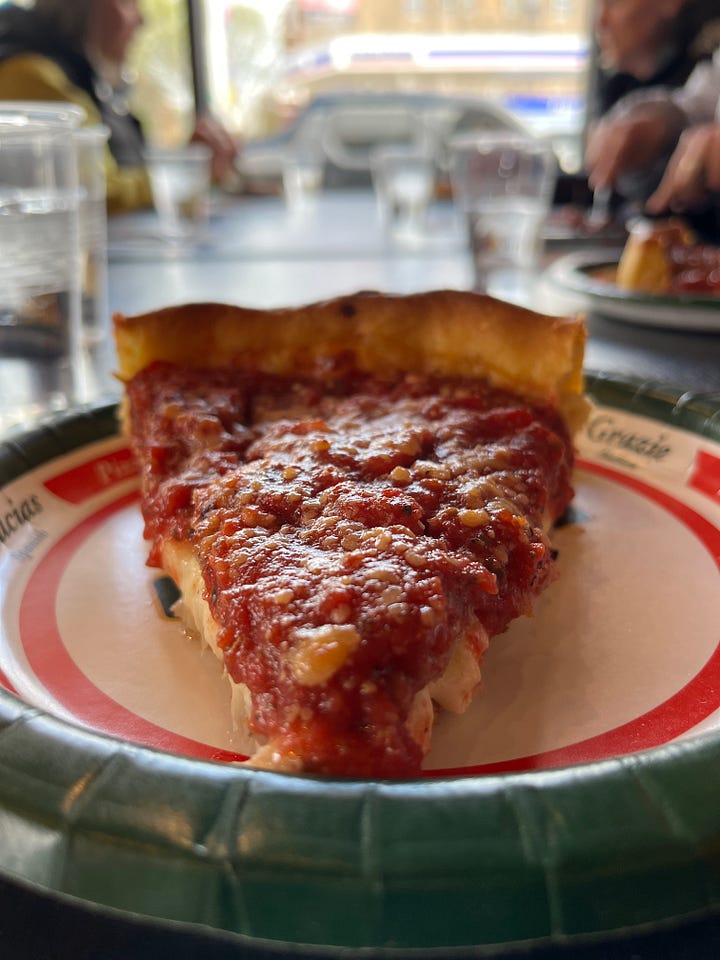
Bartoli’s pizza hits in all the traditional ways you’d expect from a classic deep dish, with a thick, buttery crust, chunky tomato sauce, and tons of rich mozzarella. They also used a significant amount of cornmeal in their crust, like Gino’s, which gives it a unique and distinct finish. Jonathan places the same order for every tour, a sausage pie and a spinach, and after tasting both it’s hard to argue with his logic:
“There’s no doubt my favorite pizza there is the sausage deep dish. That’s nostalgia. And to me, if you’re gonna eat a deep dish pizza that’s the way you get it. They do an awesome job with the spinach one as well. It’s balances it out, because they use a mixture of California tomatoes, and one of them is a very, very sweet tomato, so the spinach helps cancel some of that sweetness out. And they add more cheese to that one as well. It’s a great slice. So if I’m leading a tour and I’m thinking today I’m eating at Bartoli’s, that’s the only place I’m gonna eat, if all the sausage is gone I’m totally cool if only spinach is left. And Brian is a great guy. I knew him a little bit before the pandemic, but I’ve been working with him now for three years, and seeing him work through the struggles of running two restaurants, going back and forth up Ashland all day, he works hard at it and he really cares about the product.”
Bartoli’s felt like our quickest stop of the day, but we were all insanely full at that point and ready to hop on the bus and head back.
So what kind of person is a pizza tour from Chicago Pizza Tours for? If you would have asked me before Tim and I went, my lazy answer would have been tourists. I live in Chicago. And I pay waaaaaay too much attention to its pizza. But after finishing up our day and getting dropped back off at Pizano’s, Tim and I were in agreement, not only did we learn a lot of new info about the history of Chicago pizza, but we both also simply just had a ton of fun. If there’s a constant thread that comes up anytime I interview someone for the newsletter, it’s how happy pizza makes people. So what’s not to love about spending four hours on a Saturday eating as much pizza as you can with a bunch of friendly strangers from all over the world?
And as for the notion that the tour is just for tourists, Jonathan has worked incredibly hard to ensure that it isn’t:
“I try to convey this on the website, but I don’t always know if I do a good job: it’s not a kitschy experience by any means. We’re not hitting the stereotypical places. I design this tour for locals, with the understanding that I’m getting the visitors anyway. I want it to be locally approved, “Yes! That’s a good pizza tour.” It’s an authentic Chicago pizza experience. It’s something I take very seriously, and I analyze things over and over again to make sure that we’re sticking to that. If there’s a great new pizzeria that opens up and reaches out, I’d love to work with them too, so I’ll tell them to hang with me for a bit because you never know how an opportunity may present itself.”
Huge thank you to Jonathan (and James and Ms. Carolyn). I highly recommend Chicago Pizza Tours for anyone and everyone, and in addition to the tour I took (the original), they also offer a Downtown Pizza Walk, and a Bucktown Pizza Crawl.
I’ll end with this bonus question and a bit of news:
CPN: Is there any place you’ve always wanted to take a tour, but you haven’t been able to for whatever reason?
Jonathan: In the early days, it was Nick Lessins’ place up on the Northside, Great Lake Pizza. But it totally made sense not to do that. That was a special thing. But I’m gonna say no, because if there was, I probably would have figured out a way to incorporate it. We’ve been in business 14 years, and I don’t know how many thousands of tours we’ve run, but I’ve only taken one tour to Vito & Nick’s. That’s a little sad in my mind, but at least I’ve taken one there. To get people from downtown to there and back, that’s your whole day. You hit some Saturday traffic with that one and I don’t know what to tell you.
I was living in Los Angeles during Great Lake Pizza’s heyday, so I never had the opportunity to try it. However, I’ve heard enough serious pizza people reference it with the same sort of sort of astonished reverance to understand that it was something truly special.
Great Lake closed its doors 11 years ago, but apparently it’s coming back.


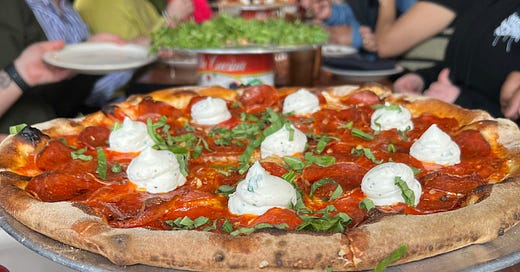


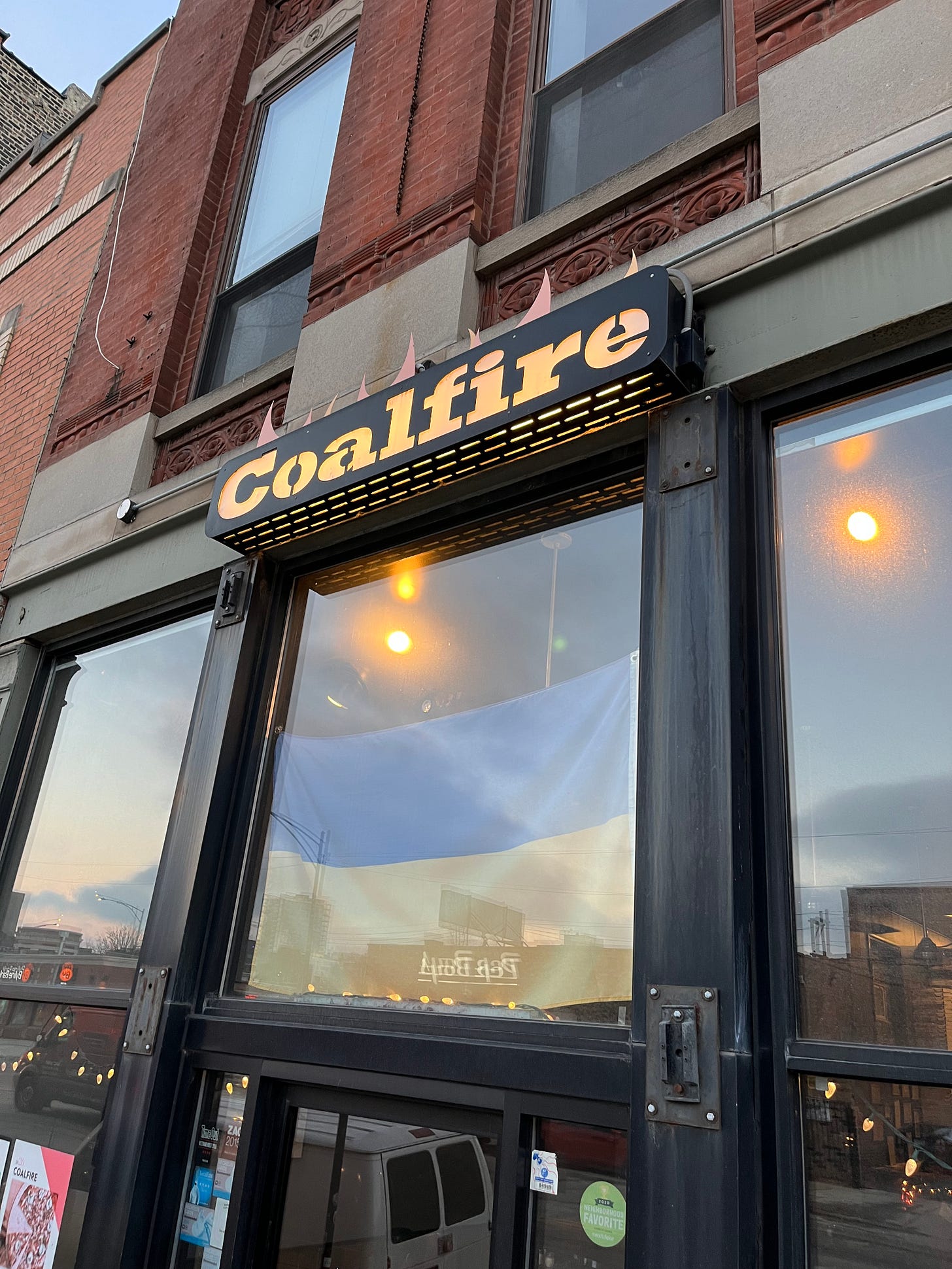

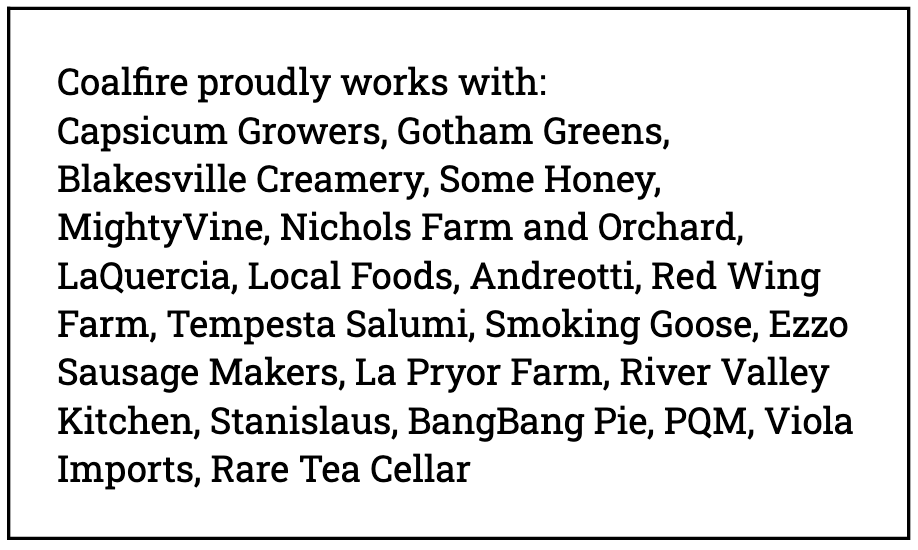
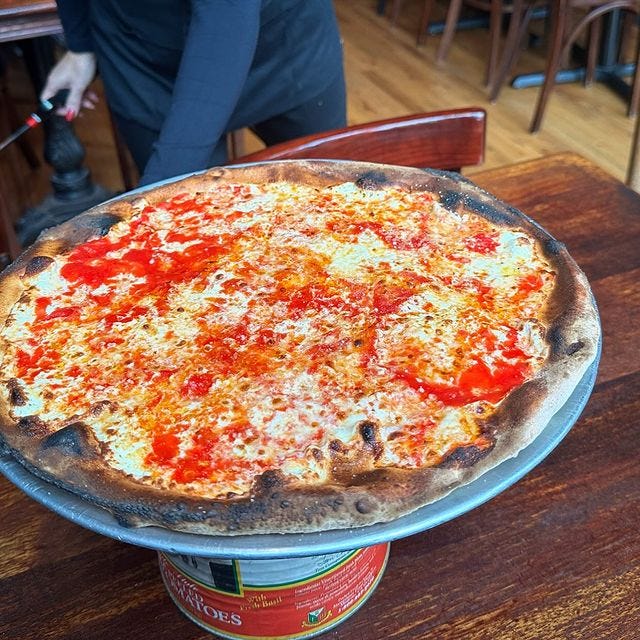
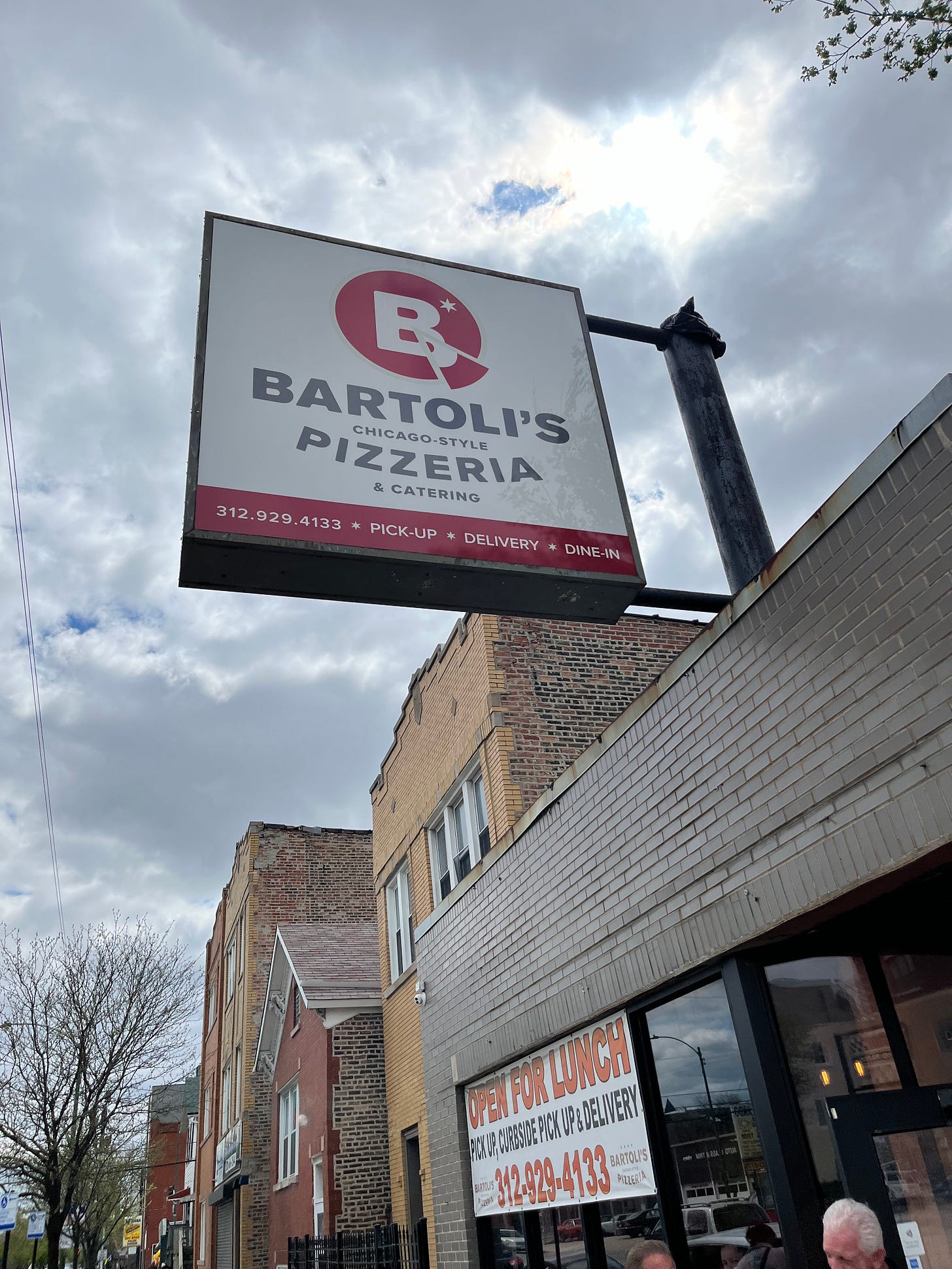

I want to go on this pizza tour!